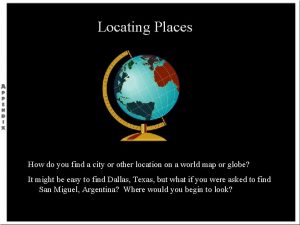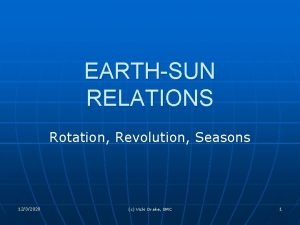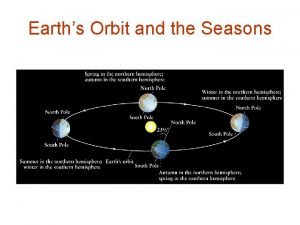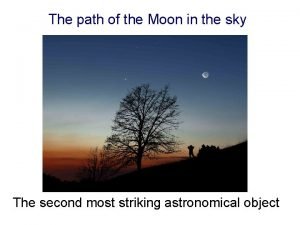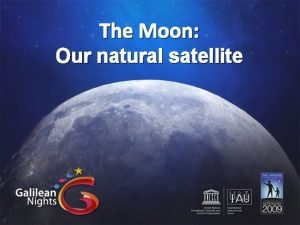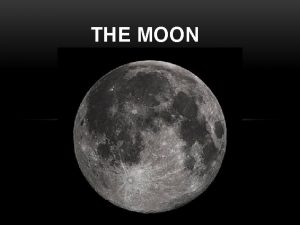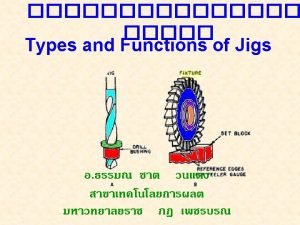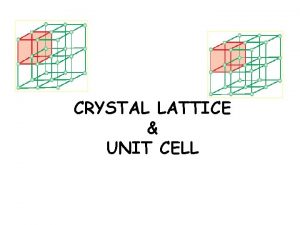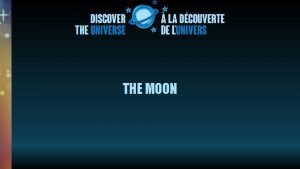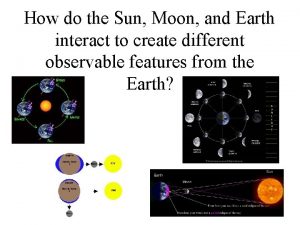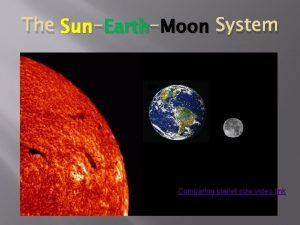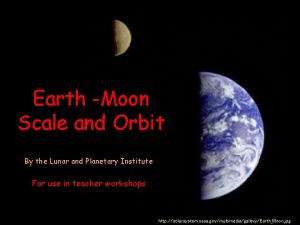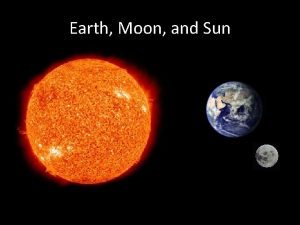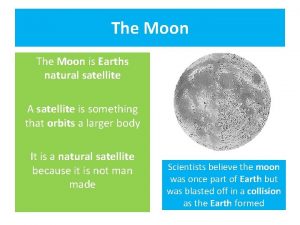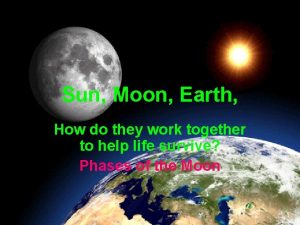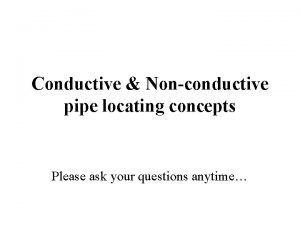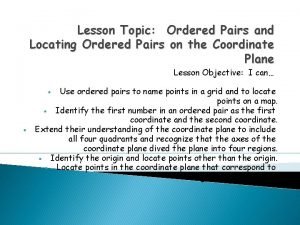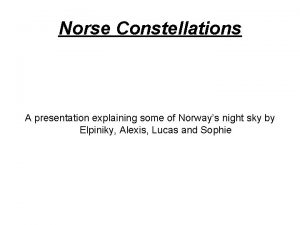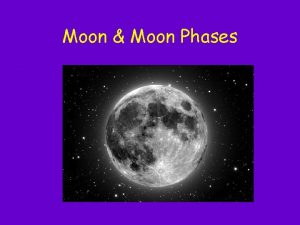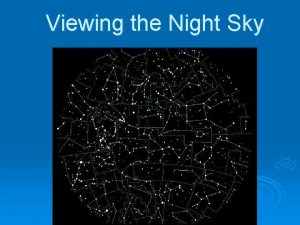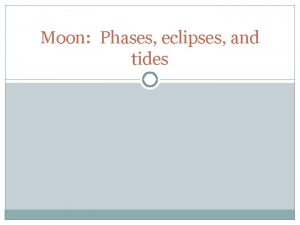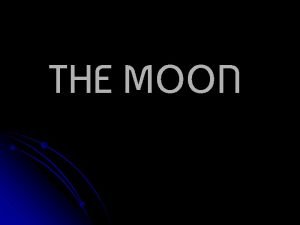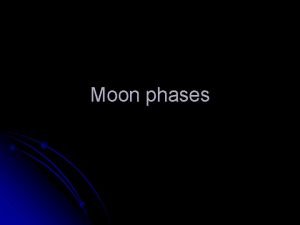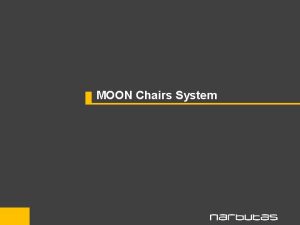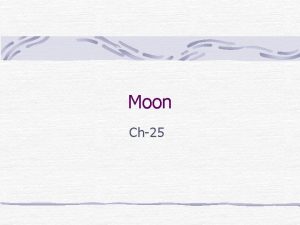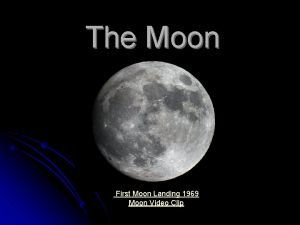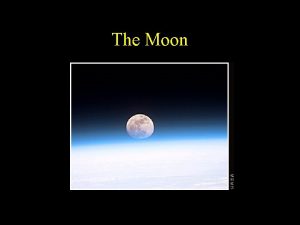Earth Moon and Sky Locating Places Constellations Seasons





































- Slides: 37

Earth, Moon, and Sky § § § Locating Places Constellations Seasons Keeping Time and Calendars The Moon: Phases and Periods Tides Earth, Moon, and Sky 1

Latitude and Longitude Places on The Earth: Cleveland 81° 36' 30"W 41° 30' 09" N • Latitude: Measured North - South From the Equator. • Cardinal Directions: NSEW - East is the direction of Sunrise on an Equinox. • Longitude: Measured From the Meridian Passing through Greenwich, England. • Meridian: A line passing through the poles and perpendicular to the equator. Meridians are line of equal longitude. • Great Circle: Shortest distance between any two points on the Earth, Moon, and Sky 2

Geometry We Will Need The Sum of the Angles in a Plane Triangle Is 180° α = 90 - β α β β α Earth, Moon, and Sky 3

Latitude N Zenith Latitude Earth, Moon, and Sky 4

Latitude N N Zenith Latitude Horizon Earth, Moon, and Sky 5

Latitude N N Zenith Latitude 90 -Latitude Horizon Earth, Moon, and Sky 6

Constellations Apparent Groupings of Stars Earth, Moon, and Sky 7

Constellations II Earth, Moon, and Sky 8

Stars and Constellations Earth, Moon, and Sky 9

Right Ascension and Declination Places in the Sky • Right Ascension: EW Component of the Position • Zero Point is where the Sun crosses the celestial equator going north: the Vernal Equinox • Celestial Equator: Projection of the Earth’s Equator into the sky • Eastward is “positive” -the right ascension increases as you go east. • Units are Hours: 1 Hour = 15 degrees • Declination: NS Component of the position • Units are degrees Earth, Moon, and Sky 10

The First Point of Aries Why is the First Point of Aries Not In Aries? ==> Precession! Earth, Moon, and Sky 11

Precession Earth, Moon, and Sky 12

The Celestial Sphere • Diurnal Motion • Daily Due to Rotation of the Earth • Annual • Yearly Due to Revolution of the Earth, Moon, and Sky 13

Annual Sky Earth, Moon, and Sky 14

Seasons • Perihelion for the Earth Takes Place about 2 January. • When It is Summer in the Northern Hemisphere it is Winter in the Southern Hemisphere. • Can The Earth Sun Distance Play a Major Role in the Seasons? NO! For the Northern Hemisphere seasons: Earth, Moon, and Sky 15

Seasons Earth, Moon, and Sky 16

Solar Heating • How does the area illuminated change? • It a • • • a = 1 meter a/b = sin(α) b = 1/sin(α) α b Earth, Moon, and Sky goes as the inverse of the sine of the angle of incidence (α). At the latitude of Cleveland: • In winter α = 23° so the area = 2. 56 Units • In summer α = 71° so the area = 1. 06 17 Units

The Length of Days N The other strong influence is the length of days: Summer Days are longer - In fact at the North Pole the Sun neither rises or sets Earth, Moon, and Sky 18

Tropics and Circles Earth, Moon, and Sky 19

The Length of A Day • The Mean Solar Day: The amount of time between successive meridian crossing of the Sun. This is 24 hours • Sidereal Day: The amount of time between successive meridian crossing of a star. This is 23 hours 56 minutes. Earth, Moon, and Sky 20

Calendars • Egyptian calendar: They derived a calendar of 365. 25 days which became the basis of the • Julian calendar - 365. 25 days (Leap year every 4 years). • Problem: The tropical year is 365. 2422 days so over 1000 years the Julian Calendar will be off by 7. 8 days. By 1582 the Vernal Equinox was coming on 11 March. • Gregorian Calendar: Better Approximation. For a century year to be a leap year it must be divisible by 400. Earth, Moon, and Sky 21

Local Time and Zone Time • Local Time: When the Sun Passes through the local meridian it is Local Noon. • Zone Time: When the Sun Passes through the Prime Meridian (0° longitude) it is Noon there and for 7. 5° East and West of that Longitude. • The centers of the Zones are at 15° spacing starting at 0°: 0, 15, 30, 45, 60, 75, 90, etc • EST is centered at 75° longitude. • Zone Time was put in place by railway companies in the late 1800's. Earth, Moon, and Sky 22

Lunar Phases Earth, Moon, and Sky 23

Lunar Rotation Period = Revolution Period Earth, Moon, and Sky 24

Sun Lunar Rotation and Revolution • The Lunar Month = Time From New to New Moon = 29. 5306 days • The Lunar Sidereal Period is 27. 3217 Days. • The Lunar Rotation Period is 27. 32 days. We Always See the Same face (more or less). Earth, Moon, and Sky 25

Lunar Eclipses • Since Lunar Eclipses Happen only at Full Moon and Do Not Occur Every Month • The Orbit of the Moon Must Be Inclined with respect to the Earth-Sun plane (the ecliptic) (The tilt is about 5 degrees). • The Cycle Of Lunar Eclipses is not One Year (ie, repeating eclipse seasons separated by 6 months) but 19 years so the orientation of the tilt must change with the 19 year period! Earth, Moon, and Sky 26

Lunar Eclipses The Lunar Orbit is Inclined at 5. 2° with respect to the Earth’s Equatorial Plane. Earth, Moon, and Sky 27

Lunar Eclipse Cycles Earth, Moon, and Sky 28

Solar Eclipses Earth, Moon, and Sky 29

Solar Eclipse: South Africa June 2001 Earth, Moon, and Sky 30

Tides: Lunar And Solar • • • So if these are the forces why are there two tidal bulges? One must consider the net force with respect to the Earth’s center! From each force subtract the center force B and what one gets is an outward force at C and A. (These are vector subtractions - Since B is greater than C when subtracted the result has the opposite 31 Earth, Moon, and Sky

Tides II • The forces shown are at the sub-lunar point. At other latitudes the force vectors point towards the sub-lunar point causing the water (or land!) to flow towards that point. • There are generally two high and two low tides per day. • The Earth turns through the water build up at the sub-lunar point. The sub-lunar point moves as the Moon does which means the tide spacing is not 6 hours but slightly less. Earth, Moon, and Sky 32

General Tide Strength Earth, Moon, and Sky 33

Measuring Distances • Triangulate the Distance Trigonometric Definitions for Right Triangles • Sin(α) = Opposite / Hypotenuse • Cos(α) = Adjacent / Hypotenuse • Tan(α) = Opposite / Adjacent • α • • Measure distance AB and the angle α. Distance = AB * tan(α) So if α = 52° and AB = 450 m then AT = 576 m. Note that one can do this by a scale drawing! Earth, Moon, and Sky 34

The Small Angle Formula L R C α L / 2πR = α / 360 α = 360/2π * L/R L = 2πα/360 * R L=θR 2πα /360 is the angle measured in radians: 360° = 2π radians or 1 Radian = 57. 296° For Small Angles Arc (L) = Chord (C) Earth, Moon, and Sky 35

Parallax The apparent motion of a relatively close object with respect to a more distant background as the location of the observer changes. The angle shown in the diagram is too small to be detected for stars. For stars one uses the orbit of the Earth as the baseline. Earth, Moon, and Sky 36

Stellar Parallax The largest is about 0. 76" Earth, Moon, and Sky 37
 Locating places
Locating places Part d earth science regents
Part d earth science regents Revolution of earth seasons
Revolution of earth seasons How seasons work
How seasons work Seasons of the year earth's position
Seasons of the year earth's position The sky is black the moon is white
The sky is black the moon is white Path of the moon in the sky
Path of the moon in the sky The science duo
The science duo Which moon phase occurs directly before a new moon
Which moon phase occurs directly before a new moon Moon sister moon calendar
Moon sister moon calendar Home.hiwaay.net/ krcool/astro/moon/moon tides/
Home.hiwaay.net/ krcool/astro/moon/moon tides/ Home.hiwaay.net/ krcool/astro/moon/moon tides/
Home.hiwaay.net/ krcool/astro/moon/moon tides/ Angle plate jig diagram
Angle plate jig diagram Recruitment is the process of locating identifying and
Recruitment is the process of locating identifying and Tetrahedral holes in fcc
Tetrahedral holes in fcc Lord of all creation of water earth and sky
Lord of all creation of water earth and sky Significant cigarettes igcse
Significant cigarettes igcse When the sun passes between the moon and earth
When the sun passes between the moon and earth How does the earth sun and moon work together
How does the earth sun and moon work together What season is this
What season is this Sun earth comparison
Sun earth comparison Earth and moon to scale
Earth and moon to scale Earth vs sun
Earth vs sun New moon position of sun and earth
New moon position of sun and earth Earth and sun relationship
Earth and sun relationship How does the sun moon and earth work together
How does the sun moon and earth work together Rules in selection of core
Rules in selection of core Non conductive pipe
Non conductive pipe Four ways of locating the ethical in you
Four ways of locating the ethical in you Champion cooling company is locating a warehouse
Champion cooling company is locating a warehouse S minus p time interval
S minus p time interval Smart city locating
Smart city locating Stated main idea definition
Stated main idea definition Locating ordered pairs on the coordinate plane
Locating ordered pairs on the coordinate plane Year round constellations
Year round constellations Viking constellations
Viking constellations Les constellations les plus connues
Les constellations les plus connues Yujin constellations
Yujin constellations
